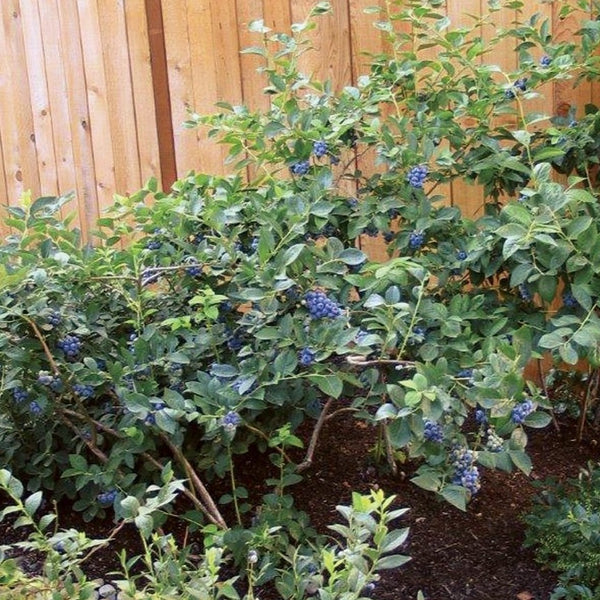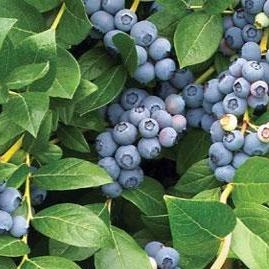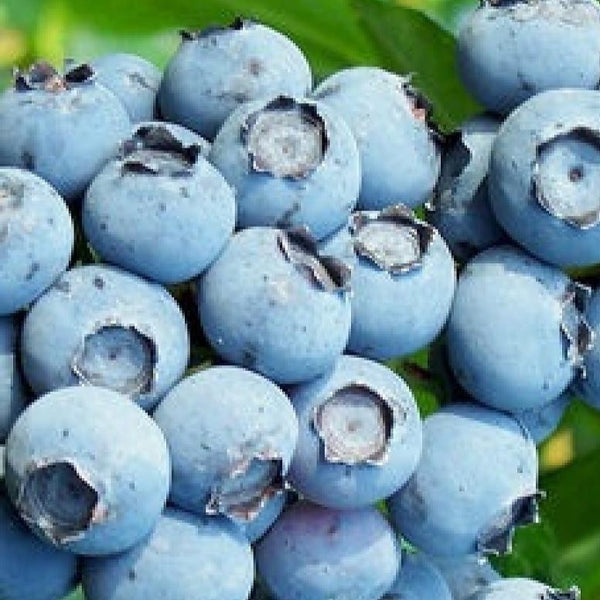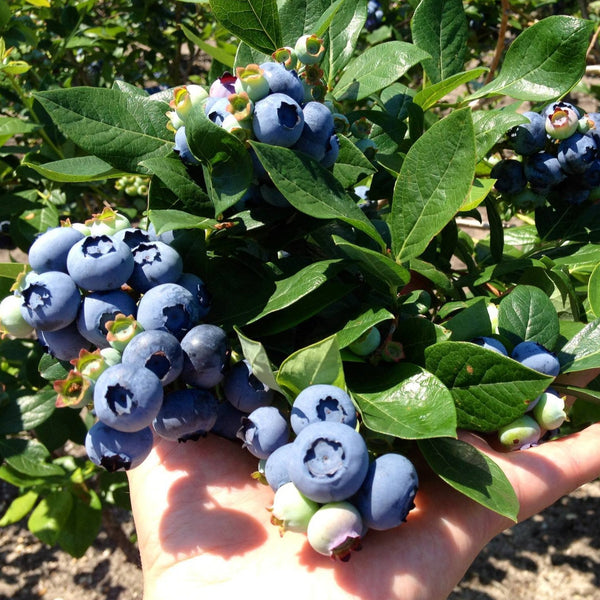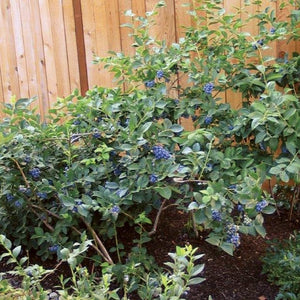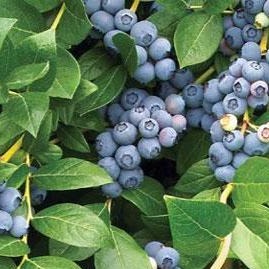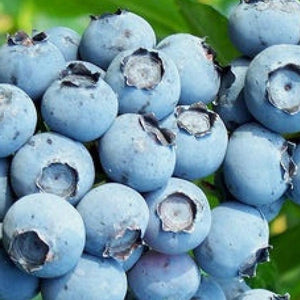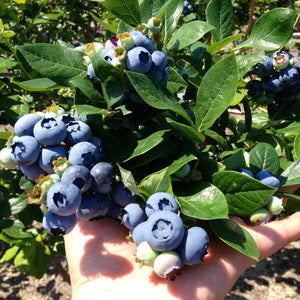Toro Blueberry
Product Details
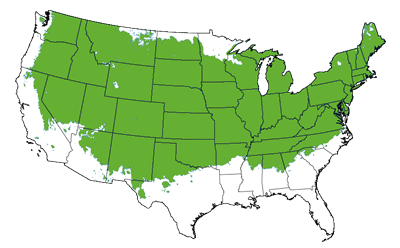 Growing Zones 4-7
Growing Zones 4-7
| Soil Type | Acidic, Well Drained |
| Sunlight | Full, Partial |
| Drought Tolerance | Good |
| Mature Width | 3-4 Feet |
| Fall Color | Red |
| Bloom Color | Pink, White |
| Shipping Restriction | AK, AZ, CA, GA, HI, MI, OR, WA |
The Toro Blueberry bush is a Northern High bush variety that requires 800 to 1000 chill hours to fruit. The blueberries are large, juicy, and sweet, never tart. These delectable berries are perfect for fresh eating, baking, and cooking. The Toro Blueberry plant is self pollinating and an extremely heavy producer so if you can only have one plant the Toro should be your top pick!
Gorgeous, bell-shaped white and pink flowers add a lovely feminine touch to this attractive shrub in spring. This mid-season blueberry produces ripe berries in July. The Toro shrub grows to 5 to 6 feet tall and 3 to 4 feet wide and is prized as the most beautiful blueberry bush. Because of this it is often used as an ornamental landscape shrub. In spring, summer, and early fall the foliage is pretty, dark green, and crisp. The Toro Blueberry has stunning red fall foliage that adds a great pop of color to your landscape.
Key Features:
- A prolific producer with large, sweet berries. This hardy blueberry offers a huge yield of plump, tasty blueberries that are packed with nutritional benefits.
- Dual duty as a pretty landscape shrub or hedge!
- Grow your own healthy fruit with the Toro Blueberry plant. This blueberry plant is compact enough to grow in containers.
- Self fertile. You only need one plant to get plenty of fruit from the Toro Blueberry.
Pro Tip: While the Toro Blueberry is self-pollinating, cross pollination from another Northern Highbush variety like the blueray or the bluecrop will increase the yield and even the fruit size of your Toro Blueberry bush.
 |
Where Should I Plant A Toro Blueberry Shrub?
Plant in a spot that has well drained, acidic soil with full sun to part shade conditions in grow zones 4-7.
Is This Blueberry Self Pollinating?
The Toro will produce large sweet berries on its own but can be pollinated with any variety. Expect the ripening to last from June to August.
When Should The Toro Blueberry Bush Be Pruned?
Prune your Blueberries in late winter to remove any dead, dying, or crowded branches and to maintain size.
When planting your Toro Blueberry be sure to choose the right location and conditions for your new plant to thrive. Spring and fall are ideal times to plant, but as long as you take care to avoid temperature extremes, you can plant throughout the year.
Blueberry shrubs thrive in full sun and well-drained, moist, acidic soil. Blueberries grow best in a pH of 4.5 to 5.5. If you have alkaline soil, be sure to amend your soil. To acidify your soil, amend with compost and/or elemental sulfur. Mulching with pine straw or pine bark will help over time as they begin to break down, but are not an immediate solution. To improve drainage in something like a heavy clay soil, add compost and be sure to loosen up the soil well before planting. Water deeply when planting and 2-3 times weekly for 3 months while your Blueberry plant is establishing. During the growing and fruiting seasons, a blueberry will do best if the soil is kept moist. Adding a layer of 2 inches of mulch is highly recommended for Blueberry bushes. Mulching helps to maintain soil moisture, keeps weeds at bay, and gives added protection during extreme temperatures. Fertilize when planting and in spring with our balanced, slow release fertilizer. Blueberries grown in containers will need fertilized 2 times per year during the growing season as nutrients leech out of the pot when you water. Prune your Blueberries in late winter to remove any dead, dying, or crowded branches and to maintain size. The Toro blueberry bush does not require a pollinator to produce fruit. However planting with other Northern Highbush varieties like Bluecrop or Blueray will increase yields and even fruit quality through cross-pollination.
The best way to prevent disease and pests is by providing the appropriate care for your plants. Proper location choice, watering, and fertilization are the keys to your success. The biggest pests of blueberries are birds. You can put up bird netting to protect your crop. If positioned properly, this is an extremely effective deterrent. Most insect pests feed on the leaves of blueberries. You can treat most of these pests naturally with horticultural oil, neem oil, or insecticidal soap. Blueberry Bushes can occasionally encounter fungal issues. Generally, treating after infection isn't extremely effective, so if you have problems yearly treat in early spring with fungicides to prevent infection. Neem Oil is an organic method of treating and preventing some fungal diseases and pests. The entire shrub must be coated in order for this method to be effective.
The Toro Blueberry bush makes a great landscape shrub. The size of this bush, its shrub-like habit, and its lush and colorful foliage make it an excellent landscape specimen. It can be used alone as a focal shrub or planted in a group with other blueberry plants. Planting with other blueberry bushes will increase your fruit yield with cross pollination. Combine two needs in one with the Toro Northern High bush blueberry plant. You can enjoy tasty, home-grown fruit and fill in your landscape with a low maintenance shrub.
Learn when to prune your flowering shrubs.
For additional options, be sure to browse our Blueberry Bushes, Dwarf Tree and Fruit Trees collections.


